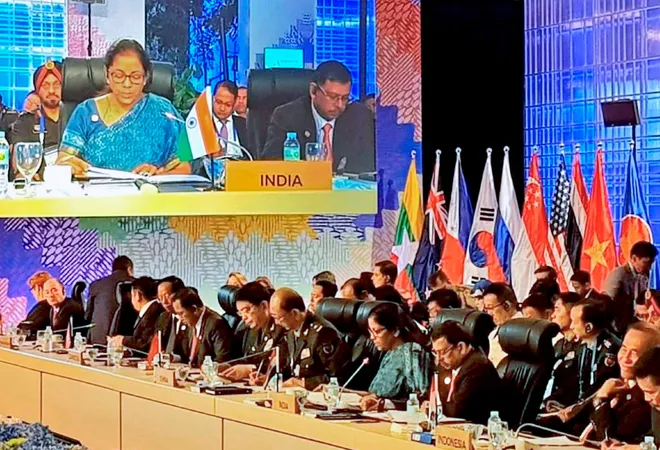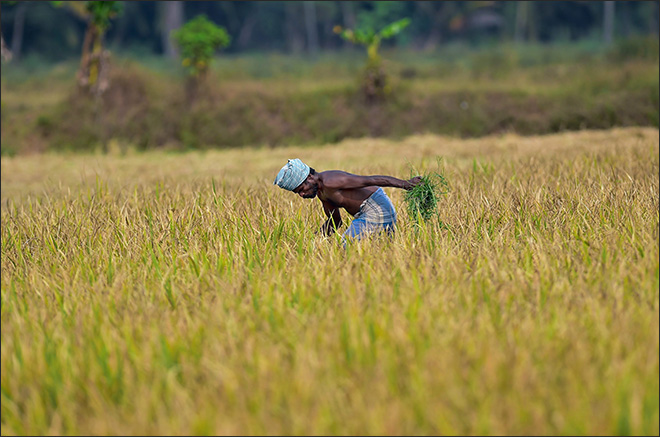-
CENTRES
Progammes & Centres
Location
Political knee-jerks are easy to play with — a loan waiver here, an extension of farming permission there, a rise in procurement prices looming and so on. But finally, to fix the agriculture problem, what’s needed is a new approach to the sector.

As public policy, the problem of agriculture in India can be broken down into several parts, each more troubling than the next, more complex than perceived. And until these disparate parts come together into a cohesive and integrated whole, they will continue to pull at our conscience, tug our hearts, make them bleed. For the over 30,000 farmers who walked from Nashik to Mumbai <1>, we express our ‘solidarity’ by providing food and water <2>, our angst by creating hashtags <3> (#LongMarch, #FarmersMarch, #KisanLongMarch), our support by shooting pictures of bleeding feet in tattered slippers. We will nurture a tumultuous politics around it, convert farmers’ demands into a government versus the Opposition. All through, solutions to the problem remain elusive.
While the 180 km long walk of farmers over seven days, with stories about their peaceful protest and the support they got from citizens, particularly from Mumbai, seems to have ensured the political demands of farmers are met, it is once again a band aid to prevent further bleeding than a more permanent remedy that heals the wounds.
We will nurture a tumultuous politics around it, convert farmers’ demands into a government versus the Opposition. All through, solutions to the problem remain elusive.
By themselves, the demands are straightforward — loan waiver to be extended for loans from 2008 and not just 2009, implementation of Forest Rights Act <4> (FRA), minimum support price for farm produce as recommended by the Swaminathan report, and the Nar-Par and Daman Ganga and river-linking projects to bring water to drought-prone areas, all of which have been accepted by the Maharashtra Chief Minister Devendra Fadnavis. This will calm the nerves for the moment or until the next political opportunity presents itself, nothing more.
What, then, ails India’s agriculture? Not one, there are eight ailments:
First, people to output ratio. The share of agriculture in India’s GDP has fallen consistently from more than 42% in 1950-51 to less than 13% <5>. Taking a more technical parameter of value added by agriculture to GDP — net output of the sector — the trend of India’s farm sector has mirrored the world. It has fallen to less than 18% from more than 44% in 1960 (China: from 23% to 9%; Brazil: 21% to 6%; South Korea: 39% to 2%; and the world: 8% to 4%) <6>. The problem for India is despite its economic pipelines now linked to services (its share of GDP has risen from less than 35% in 1950 to more than 67% today <7>), the number of people eking a livelihood from agriculture has remained static — it was 50% in 1950 and stands at 49% today. In contrast, between 1991 and 2017, employment in agriculture as a percentage of total employment has fallen across the world. The share of China has reduced to 27% from 55%, that of France has halved to 3%, Germany has seen it crash to 1% from 4%, Thailand to 34% from 60% <8>. The pressure on agriculture on a per capita basis, therefore, has risen in India and is not showing any inclination to change.
Second, return on investment (land, capital and labour). The returns from agriculture have remained low. Prime Minister Narendra Modi’s aspiration to double farmers’ incomes by 2022, when India completes 75 years of its Independence, needs reforms that look outside the policy boxes of today (more on those disruptive policies in a future essay). These policies have focussed on ensuring food security for the country through greater output but not farmers’ incomes; on seeds, fertilisers and irrigation but not on returns to farmers. This is best illustrated by the expanding differential between farm income and non-farm income. In the early 1980s, farm income per cultivator was 34% of what a non-agriculture worker earned. It fell to 25% in 1993-94, a trend that broke mildly in 2004-05 to 2011-12 but has deteriorated during 2012-13 to 2015-16, according to a NITI Aayog report <9>.
Third, efficiency of agriculture. The productivity of India’s farming remains low <10>. In rice, against the average world yield of 4,548 kg per hectare, India’s yield stands at 3,721 kg per hectare, lower than China’s 6,775, Brazil’s 4,786, Pakistan’s 4,068 and Indonesia’s 5,136. In wheat, India’s yield in kg per hectare is 3,177, lower than China’s 4,987 and France’s 7,599 but higher than Australia’s 2,215 and Pakistan’s 2,709. There are huge gains to be had if productivity rises. It’s like an increase in the margins of a company’s products — by producing the same output, you get a higher return. Without productivity — which in turn is based on capital investments in technology and consolidation of farms to bring about economies of scale — it will be impossible to ensure a greater return to farmers through existing policies.
Fourth, victories on the political front are partly pyrrhic. Those celebrating the march and the allowance by the Maharashtra government to allow them to extend farming in forest areas, for instance, will at some point need to wake up to the fact that statistically the forest cover of India just got reduced. Now that farmers can farm in what was known as ‘forest’, it will show up in the next survey as a loss of forest cover. You could say the same area could have been converted into a forest through plantations. Now, it’s been given away. To whom will remain a long battle as politically connected beneficiaries take big and profitable bites, leaving crumbs for the rest, an possibly raising the next crisis.
Fifth, waiveritis <11>. The issue of loan waivers has passed the escape velocity of economic logic and is now floating without the gravity of reason in entirely in the flitting domain of politics, with fiscal finances merely another tool to deliver voter aspirations. Worse, it is converting taxpayer’s money into a tool to retain political power, as an investment into the next elections. The farmer-voter knows this, uses it, and has institutionalised the functioning of what is known as a ‘moral hazard’. That’s another race to the bottom, one state at a time.
 Without productivity, it will be impossible to ensure a greater return to farmers through existing policies. Photo: R. Senthil Kumar — © PTI
Without productivity, it will be impossible to ensure a greater return to farmers through existing policies. Photo: R. Senthil Kumar — © PTI
Sixth, framing the deaths. Farmer suicides due to indebtedness make headlines all the time. According to a Brookings report <12>, however, while agricultural distress is across all farmer households and arguably more so in smaller farms, nearly 86% of all farmer suicides in Maharashtra are among those having more than two acres of landholding and 60% have more than four acres. More than 20% of all suicides are due to health (mental and physical) reasons. Bankruptcy and indebtedness account for less than 5% of all suicides. Finally, the report notes that a ‘contagion’ of suicides can occur if they are overly dramatised. So, not all farmer suicides could be due to indebtedness, questioning the viability of loan waivers.
Seventh, trickle downs. If a higher procurement price is one solution, it has the potential to wreak inflationary havoc, which has its own downward cycle through higher interest rates. Above all, it could create a bigger political issue. The problem is in using the same defunct and decaying system to play with prices and headline a feel-good. What needs to be done — and which any digitally-suave government can do — is to reduce if not end the cartel-like monopsony of middlemen and allow farmers to get direct access to consumers. Farmer cooperatives in every state can come together to ensure this but it needs a political will of state governments to create the enabling mechanism. This could even lead to a virtuous political cycle of higher return to farmers as well as reduced prices for consumers. Who, but the incumbents and their political access can argue against this?
Eighth, a manufacturing lockjaw. If agriculture is not offering an economic return, the challenge is transition to low-skilled manufacturing. But whatever the doing business rankings may say, when you speak to small and medium enterprises, you know that facts on the ground are harsh: it is not easy to do business in India. The problems are excessive regulation leading to corruption on one side and institutional hurdles such as land acquisition and change in land use on the other. When the experience of farmer-citizen with the State is one of distrust, who in his right mind will give up the only asset he has for a stake in a future that may never happen? Land acquisition is an issue that needs to be addressed urgently but the politics will prevent it from working out until 2019.
Political knee-jerks are easy to play with — a loan waiver here, an extension of farming permission there, a rise in procurement prices looming and so on. But finally, to fix the agriculture problem, what’s needed is a new approach to the sector. Agriculture has remained outside India’s economic reforms process. There are huge benefits of productivity jumps in the short term by using digital technologies and providing consumer and market access. But those too can only be a precursor to wider and deeper reforms. The long walk of 30,000 farmers from Nashik to Mumbai only highlight the longer walk of the sector over the past seven decades. With food security behind us, the new agriculture reforms and the new agricultural policy needs to be drafted keeping farmers, as individual economic agents and not merely martyrs in the economic food chain, in mind.
<1> Abhiram Ghadyalpatil, Mumbai farmer protest called off after Maharashtra govt accepts demands, Mint, 13 March 2018, Accessed on 14 March 2018.
<2> How Mumbaikars supported protesting farmers, distributed water, dates, biscuits, India Today, 12 March 2018, Accessed on 14 March 2018.
<3> Shreya Das, Sea of farmers in Mumbai: Netizens come together in solidarity with #KisanLongMarch, The Indian Express, 12 March 2018, Accessed on 14 March 2018.
<4> Forest Rights Act, 2006, Act, Rules and Guidelines, The Gazette of India, Ministry of Tribal Affairs and United Nations Development Programme, 2 January 2007, Accessed on 14 March 2018.
<5> Handbook of Statistics of Indian Economy 2016-17, Reserve Bank of India, 15 September 2017.
<6> Agriculture, value added (% of GDP), World Bank, Accessed on 14 March 2018.
<7> Handbook of Statistics of Indian Economy 2016-17, Reserve Bank of India, 15 September 2017.
<8> Employment in agriculture (% of total employment) (modeled ILO estimate), World Bank, Accessed on 14 March 2018.
<9> Ramesh Chand, Doubling Farmers’ Income: Rationale, Strategy, Prospects and Action Plan, NITI Aayog, March 2017, Accessed on 14 March 2018.
<10> Raising Agricultural Productivity and Making Farming Remunerative for Farmers, NITI Aayog, 16 December 2015, Accessed on 14 March 2018.
<11> Gautam Chikermane, Waiveritis: Outbreak of a fiscal epidemic, Observer Research Foundation, 27 June 2017, Accessed on 14 March 2018.
<12> Shamika Ravi, Farmer suicides is not just issue of debt, 4 August 2015, Accessed on 14 March 2018.
The views expressed above belong to the author(s). ORF research and analyses now available on Telegram! Click here to access our curated content — blogs, longforms and interviews.

Gautam Chikermane is Vice President at Observer Research Foundation, New Delhi. His areas of research are grand strategy, economics, and foreign policy. He speaks to ...
Read More +